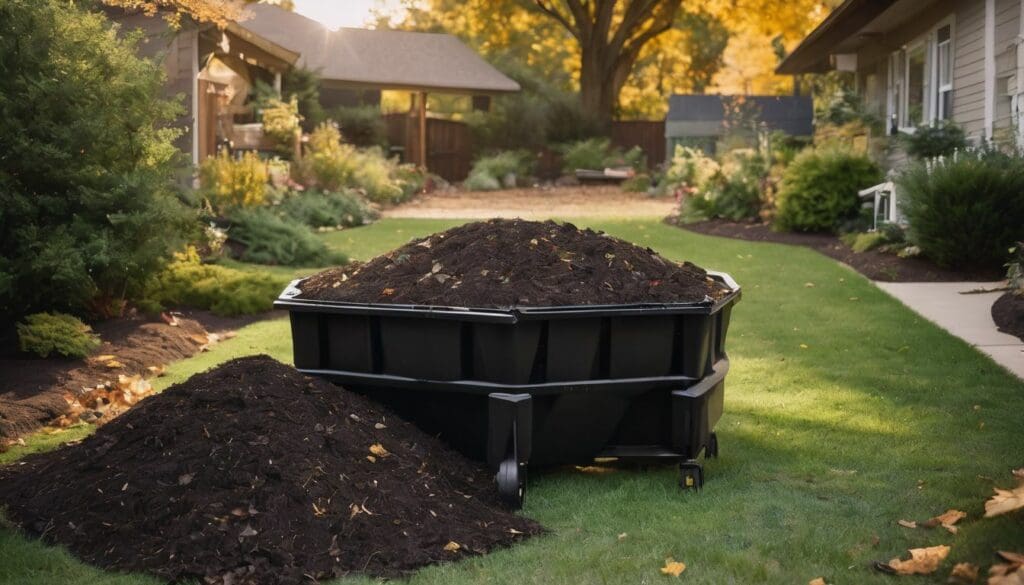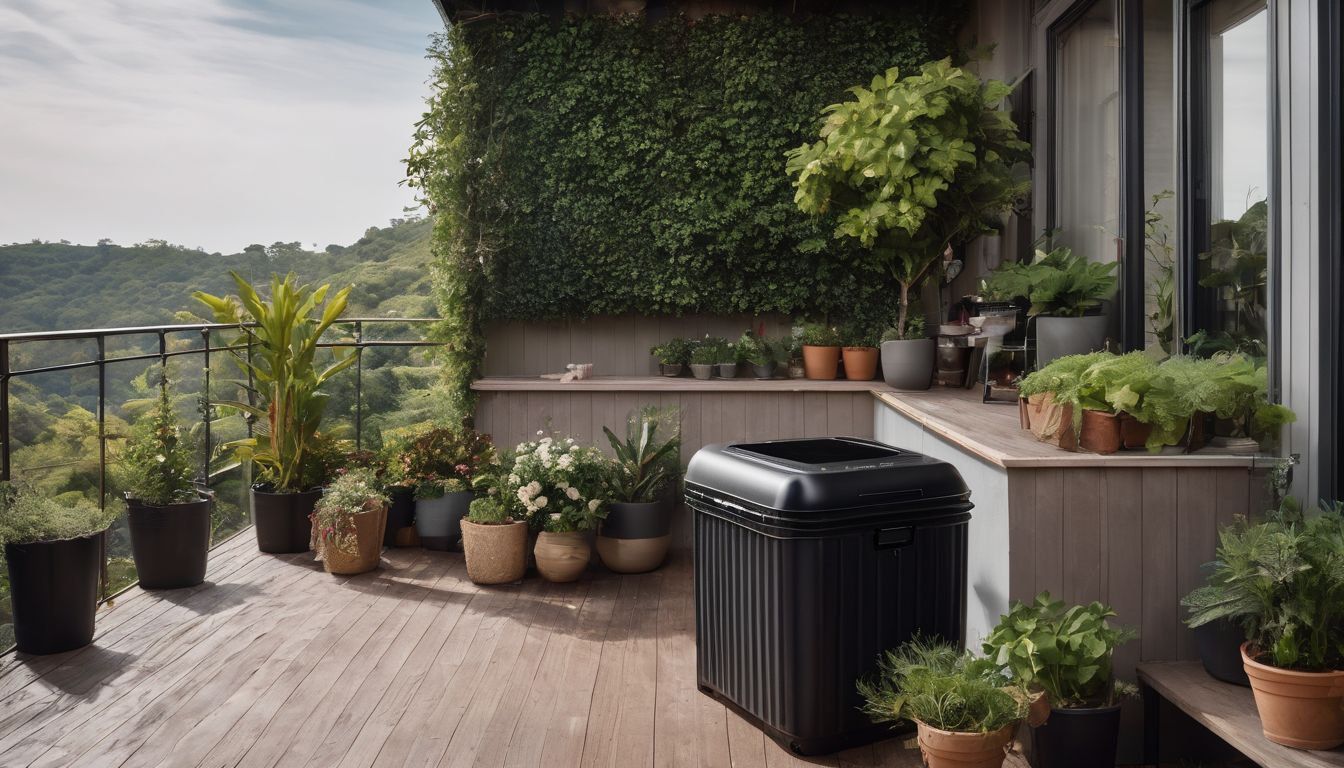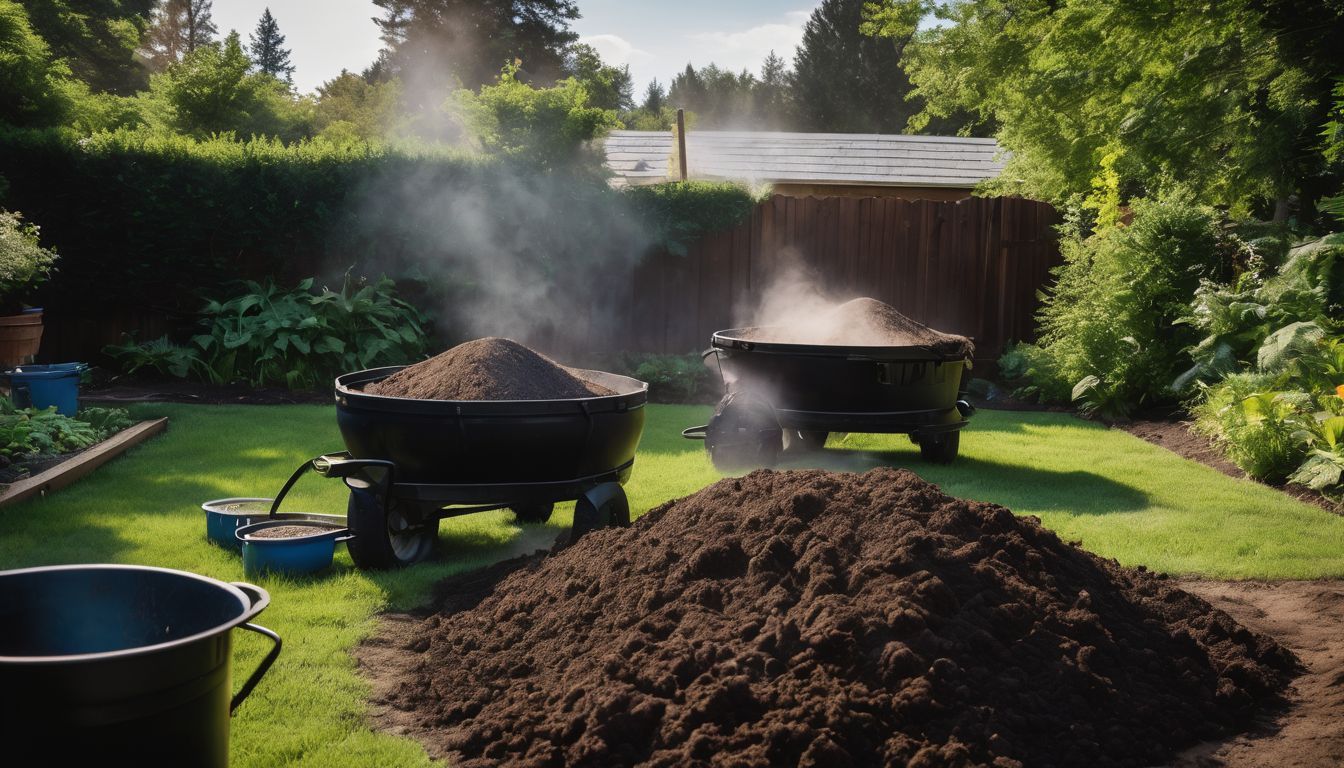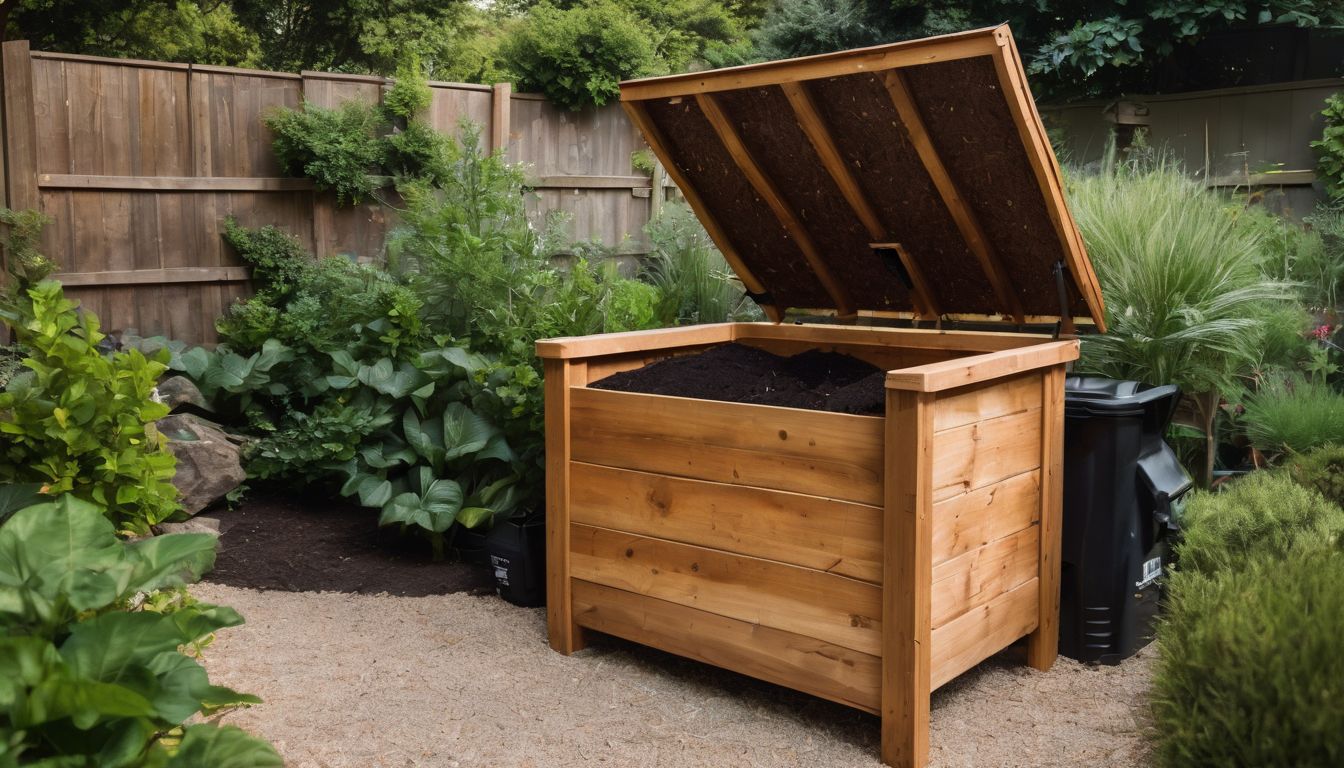Are you staring at piles of fallen leaves and cut grass, wondering what to do with them? Every year, tonnes of garden waste are tossed aside, much of it ending up in landfills. Our guide will shed light on transforming this ‘waste’ into a treasure for your garden through composting.
Dive in to turn over a new leaf!
Key Takeaways
- Composting leaves and yard waste helps reduce the amount of organic material sent to landfills, cutting down on methane emissions and saving landfill space.
- Turning garden and kitchen scraps into compost creates a natural, nutrient – rich soil enhancer that lessens dependence on chemical fertilisers and saves money.
- A successful compost pile needs a balance of green (kitchen waste, grass clippings) and brown (dry leaves, twigs) materials. Regular turning ensures proper aeration for decomposition without foul odours or pests.
- Common methods for home composting include using bins or tumblers; larger spaces may suit traditional pile composting. Each method requires regular maintenance like turning the mix to facilitate breakdown.
- Troubleshooting common issues in composting ensures an efficient process; this includes managing moisture levels, balancing materials to deter odors, securing piles against pests, and keeping the right temperature for quick decomposition.
Benefits of Composting Leaves and Yard Waste
Composting leaves and yard waste has numerous benefits, including reducing landfill waste, creating nutrient-rich soil for plant growth, and saving money on fertilisers. By composting organic waste, you can contribute to sustainable waste management practices and support a healthier environment.
Reducing landfill waste
Every year, heaps of garden waste end up in landfills, taking up space and contributing to methane emissions. By composting leaves and yard debris at home, we can significantly cut down on the amount of organic waste that ends up in these dumps.
Compost transforms this green waste into valuable mulch, enriching the soil without relying on chemical fertilisers.
Turning kitchen scraps like fruit peels and vegetable trimmings into compost alongside your leaf piles multiplies these benefits. This simple step not only lessens rubbish truck trips but also ticks the box for sustainable waste management.
It’s a proactive move towards greener living habits that nurture our gardens and reduce our environmental footprint.
Creating nutrient-rich soil
To create nutrient-rich soil for your garden, start by layering organic materials like leaves, garden waste, and kitchen scraps. The decomposition process breaks down these materials into valuable nutrients that plants need to thrive.
Regularly turning and watering the compost heap helps maintain an ideal environment for microorganisms to do their work. With the right balance of green and brown materials, your compost will be teeming with beneficial organisms ready to enrich your soil.
Composting also reduces landfill waste while providing a sustainable way to manage green waste. By recycling biodegradable materials at home, you cut down on the need for synthetic fertilisers while contributing to a healthier environment in your community.
Saving money on fertilizers
By composting leaves and garden waste, you can create nutrient-rich soil that reduces the need for store-bought fertilisers. This can lead to substantial cost savings over time while also promoting sustainable gardening practices.
Organic matter from your compost heap enriches the soil naturally, providing essential nutrients and improving its structure – all without spending on commercial fertilisers.
Composting effectively recycles green waste into valuable resources, reducing the reliance on chemical-based fertilisers and contributing to a healthier environment. Nutrient-rich soil resulting from composted organic matter not only benefits your garden but also helps save money otherwise spent on synthetic fertilisers.
How to Compost Leaves and Yard Waste
To start composting leaves and yard waste, choose a suitable method such as bins or tumblers. Layer the materials with a mix of green and brown waste, then maintain the compost pile by turning it regularly.
Choosing a composting method (bins, tumblers, etc.)
- Compost Bins:
- Compost Tumblers:
- Pile Composting:
Layering the materials
To create nutrient-rich compost, layering the materials in your compost pile is essential. Each layer adds a different type of organic matter, leading to a well-balanced composition that promotes decomposition and prevents issues such as foul odors or slow decomposition. Here’s how to effectively layer your compost materials:
- Start with a layer of dried brown materials such as leaves or straw.
- Add a layer of green materials like grass clippings or kitchen scraps.
- Sprinkle a thin layer of soil to introduce beneficial microorganisms.
- Repeat the layers, ensuring each brown layer is covered with green material and soil.
- Continue this process until the pile reaches the desired height.
Maintaining the compost pile
Once the compost heap is established by layering the materials, it’s important to maintain it properly to ensure efficient decomposition and avoid any issues. Here are some key steps for maintaining the compost heap:
- Turn the heap regularly to aerate it and distribute moisture and microorganisms evenly.
- Monitor the moisture levels and add water if the heap becomes too dry, or cover it if excessive rain makes it too wet.
- Check the temperature of the heap regularly with a compost thermometer to ensure it stays within the ideal range for decomposition.
- Add new materials in thin layers and cover them with existing compost to keep pests away and maintain a balanced composition.
- Use a garden fork or similar tool to break up any compacted areas within the heap for improved airflow and decomposition.
- Keep an eye out for any signs of foul odours, which may indicate an imbalance in the compost, and take corrective measures promptly.
What Materials Can Be Composted
Compostable materials include non-woody yard waste, chipped wood scraps, and kitchen waste. To learn more about what can be composted and how to effectively compost these materials, keep reading!
Non-woody yard waste (leaves, grass clippings, etc.)
Yard waste such as leaves and grass clippings can be composted to create nutrient-rich soil for your garden. To begin, gather the non-woody yard waste and layer it with other compostable materials in a compost bin or pile.
Turn the materials regularly to encourage decomposition. The resulting leaf mulch will enrich your soil without contributing to landfill waste.
By recycling green waste at home, you can contribute to soil enrichment and minimise organic waste. Plus, using homemade compost reduces the need for store-bought fertilisers, making it an eco-friendly choice for environmentally conscious individuals supporting conservation efforts.
Chipped wood scraps
Chipped wood scraps, such as small branches and twigs, are excellent additions to a compost pile. They provide structure and airflow within the pile, aiding in the decomposition process.
Furthermore, they contribute essential carbon to balance the nitrogen-rich kitchen waste and grass clippings. These chipped wood scraps can help create a well-balanced mixture for successful composting.
Mixing in chipped wood scraps with other organic materials like leaves and grass clippings supports healthy microbial activity within the compost pile. The result is nutrient-rich soil that’s perfect for nourishing your garden plants without resorting to chemical fertilisers.
Kitchen waste (fruits, vegetables, coffee grounds, etc.)
Composting kitchen waste such as fruits, vegetables, and coffee grounds is an excellent way to reduce household waste. Layering these items into your compost pile with yard waste and other organic materials can speed up decomposition and create rich soil for your garden.
By diverting kitchen scraps from landfills, you not only reduce methane emissions but also contribute to a more sustainable environment.
Utilising organic kitchen waste in composting provides essential nutrients for the soil, leading to healthier plant growth without the need for chemical fertilisers. Coffee grounds specifically add nitrogen to the mix while fruit and vegetable scraps provide various minerals that enrich the compost.
Troubleshooting Common Composting Issues
Addressing common issues such as foul odors, pests and slow decomposition can help maintain a successful compost pile. Learning how to tackle these problems will ensure your composting efforts are effective and sustainable.
Foul odors
Foul odors during composting can result from too much moisture or inadequate air circulation. To address this, turn the compost pile regularly to aerate it and mix in dry materials like straw or shredded paper.
Also, avoid adding meat, dairy, or oily foods to the pile as they can cause unpleasant smells. Lastly, ensure a balanced mix of green and brown materials to promote odorless decomposition.
Unpleasant smells in your compost can be managed by locating the bin away from living spaces and ensuring proper drainage to prevent excessive moisture buildup. Regular turning of the pile is essential for maintaining airflow and promoting aerobic decomposition.
Pests and animals
Pests and animals can be attracted to the compost pile due to the presence of food scraps and organic materials. To deter pests, avoid composting meat, dairy products, or oily foods that may attract unwanted visitors.
Additionally, regularly turning or aerating the compost pile can prevent pests by disturbing their habitats.
To further address pest concerns, consider covering the top layer of your compost with a fine wire mesh or using a specifically designed composter that is animal-proof. It’s important to keep an eye out for any signs of rodents or insects around your compost area and take action swiftly if necessary.
Slow decomposition
If your compost pile is experiencing slow decomposition, consider adjusting the carbon-nitrogen ratio by adding more nitrogen-rich materials such as grass clippings or vegetable scraps.
Turning and aerating the pile regularly can also help to speed up the breakdown process. Additionally, ensure that the compost pile remains moist but not waterlogged, as moisture plays a crucial role in facilitating decomposition.
Monitoring the temperature of your compost pile can provide valuable insights into its progress. Consider using a compost thermometer to check for optimal temperatures between 135-160°F (57-71°C), which will promote faster decomposition.
Additional Resources and Tips
For additional resources and tips on home composting, you can check out print materials and online resources. You can also connect with your local government for composting resources and find tips for successful composting.
Print materials and online resources
Explore a wealth of information on garden composting, green waste recycling, and DIY composting through a variety of print materials and online resources. Discover helpful guides, instructional videos, and informative articles that offer valuable tips for successful home composting.
Connect with your local government for access to community composting resources and learn about yard waste composting regulations in your area. Tap into the organic waste recycling movement by accessing expert advice and practical tips for recycling yard waste and food scraps effectively.
Delve into the world of organic waste recycling by accessing a wide range of materials and online resources spanning from leaf composting to setting up a compost bin at home. Gain insights into turning garden waste into nutrient-rich soil while actively contributing to green waste reduction efforts in your community.
Connecting with your local government for composting resources
If you’ve exhausted print materials and online resources, consider reaching out to your local government for valuable composting resources. Your city or town may offer workshops, educational materials, or even discounted compost bins.
Additionally, they might provide information on green waste collection services or community composting initiatives that you can participate in. By connecting with your local government, you can tap into a wealth of knowledge and support for your composting efforts.
Tips for successful composting
To ensure successful composting, regularly turn the compost pile to aerate it. This helps in breaking down the materials and prevents foul odours. Additionally, keep your compost pile moist but not waterlogged; a good rule of thumb is ensuring it feels like a damp sponge.
Remember to balance the materials you add – aim for a mix of green (garden waste, food scraps) and brown (leaves, chipped wood) materials for optimal decomposition. Finally, cover your compost pile to retain moisture and heat while also deterring pests.
When layering materials in your compost bin or pile, alternate between green and brown materials to create an ideal environment for decomposition. Regularly monitor the temperature of the pile as well – if it becomes too hot or too cold, adjust the ratio of green to brown materials accordingly.
Conclusion
In conclusion, composting leaves and yard waste is a simple yet impactful way to reduce landfill waste. By creating nutrient-rich soil from garden and food scraps, you can save money on fertilisers while promoting environmental sustainability.
Get started today by choosing a composting method that suits your needs and begin turning your green waste into valuable resources for your garden. Embrace the benefits of composting and join the movement towards a greener future for our planet.
FAQs
1. Why should I compost leaves and yard waste?
Composting leaves and yard waste turns garden trimmings into nutrient-rich soil, helping your plants grow stronger and healthier.
2. What do I need to start composting at home?
To start, you’ll need a compost bin setup where you can layer your green waste with food scraps for efficient decomposition.
3. Can all garden waste be composted?
Mostly yes—green waste like grass clippings and plant trimmings is perfect for composting; however, diseased plants shouldn’t be included as they may harm the final compost.
4. How long does it take for yard waste to turn into compost?
The time it takes varies, but usually a few months are needed for garden waste composting to break down into useable compost when proper conditions are maintained in your bin.





